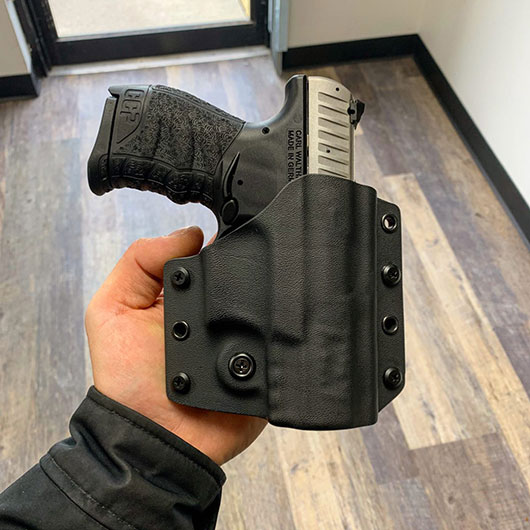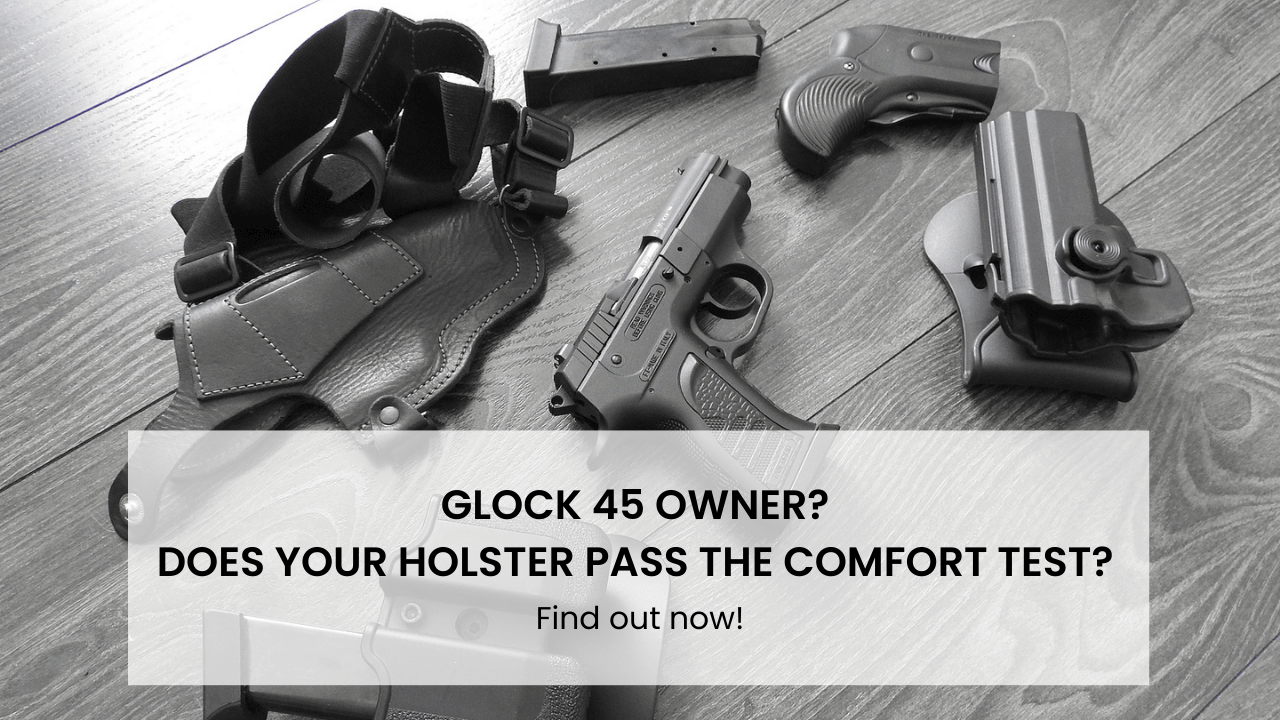Things to Consider When Purchasing a Walther PPQ M2 IWB Holster
Sep 1st 2021

A reliable, safe, and snugly fitting holster allows you to draw your weapon smoothly and efficiently in response to a deadly threat. It is one of the most important firearm accessories you can own.
If you own a Walther PPQ M2 and want an IWB holster, there are a few considerations you should keep in mind.
Walther PPQ
The Walther PPQ, introduced in 2011, is a striker-fired, polymer-framed semi-automatic pistol, replacing the P99QA. In 2013, Walther introduced the M2 variant of the PPQ, which substituted the ambidextrous paddle-type system, similar to that of some HK handguns, with a reversible push-button magazine catch, more commonly encountered in American handguns.
As with many 9mm, .40 S&W, and .45 ACP semi-automatic pistols, the PPQ uses a modified Browning short-recoil operating system. Unlike many other striker-fired handguns, in which the striker is partially cocked by retracting the slide, the PPQ’s striker is fully cocked. As a result, pressing the trigger performs only one action: it releases the cocked striker. This allows for a short, smooth trigger break in comparison with other designs.
Holster Materials
Handgun holsters are generally available in three different materials: leather, Kydex, and nylon.
Leather holsters
Typically made from tanned cowhide or horsehide, leather is widely used in holsters, knife sheaths, slings, side saddles, and other firearms accessories. Strong and durable yet softer and more pliable than thermoplastic, leather molds to the contours of your body over time. Furthermore, the softer internal surfaces tend to be less abrasive against the handgun’s finish.
Leather, however, must be chemically treated to resist water absorption and can degrade from harsh use.
Kydex holsters
Kydex is a thermoplastic developed in 1965, initially for use in the aircraft industry. Due to its high strength, and resistance to abrasion, moisture, and chemical contamination, it has become a popular choice for tactical equipment. Today, holsters, sheaths, magazine pouches, and other accessories are routinely made from Kydex.
A rigid material, Kydex maintains its shape and doesn’t deteriorate when exposed to water, oil, or cleaning solvents. It functions under a variety of adverse conditions. Kydex will hold up against mud, dirt, rain, and snow very effectively if you carry your handgun in inclement weather.
Nylon holsters
Nylon refers to a family of fabric-like petroleum-based thermoplastics. Introduced by DuPont in 1938. It was used in everything from hosiery and nylon stockings to parachutes and parachute cords in the following years.
Nylon holsters don’t provide the secure fit or retention that leather and Kydex afford, instead relying on a separate strap to retain the weapon. You’ll also find that most nylon holsters are not designed to fit a specific firearm, providing a more general fit. Nylon’s primary advantage in a handgun holster is that it’s inexpensive. Nylon, however, is less suitable than its primary competitors.
What to Look for in IWB
There are several requirements that a concealed-carry holster should meet.
Adjustable Retention
When searching for a holster for the Walther PPQ M2, your priority should be adequate retention. Retention determines the extent to which your holster securely holds your firearm, ensuring it doesn’t become loose or fall out. This is important for security and safety. If you’re ever in a situation where you have to draw your weapon in self-defense, you need it to be held in the same position consistently.
Many shooters prefer passive-retention holsters for IWB carry. These holsters use the friction between the exterior surfaces of the firearm and the interior surfaces of the holster to resist upward movement.
In Kydex holsters, two sheets of Kydex are thermoformed to the specific dimensions of the handgun, creating a custom fit. If you wear your handgun openly, an active retention, such as a thumb break, may be preferable.
Ideally, a passive-retention holster provides retention screws, allowing you to easily adjust the tension between the holster and the gun.
Adjustable Cant and Ride Height
As with retention, adjustability is a definite plus regarding cant and ride height. These two elements complement each other. You generally want enough forward cant to acquire a full firing grip on the weapon. A forward cant also reduces printing, as the butt of the pistol moves up and away from the fabric. Adjustability allows you to find the perfect balance.
Concealability
An IWB holster is designed for concealed carry. If you want to carry your handgun openly, OWB holsters are preferable. While you can carry a handgun concealed in an OWB holster, you need to drape a layer of fabric over the weapon, necessitating a jacket, coat, or untucked shirt.
By placing the holster between your waistband and your body, IWB holsters maximize concealment. However, not all holsters are created equal, and you need to find an IWB holster that minimizes printing, keeping the weapon close to your body at all times.
The holster is not the only factor affecting concealment. Experiment with different wardrobe options to find the best clothing that complements your carry holster.
You should also determine whether your IWB holster is tuckable. If your holster is compatible with this method of carry, you can tuck the fabric of your shirt over the holster and into your pants, hiding the gun even more effectively.
Comfort
Regardless of the material you choose, the holster you wear should be comfortable. While some gun owners find leather more comfortable than Kydex, this depends on your personal preferences, how you dress, and the position in which you carry. If an IWB holster doesn’t provide you with the level of comfort you need, consider buying an OWB holster.
OWB holsters, or belt holsters, are generally considered more comfortable because they don’t press against your body. You also don’t have to buy a pants size up to accommodate the increased bulk. However, OWB holsters are less concealable, requiring additional clothing to properly conceal.
Fully enclosed trigger guard
Your holster should allow you to carry your firearm safely. While this is related, in part, to retention, there are other factors to consider. The trigger guard should not be exposed. When you draw your weapon, your index finger should only be able to enter the trigger guard and contact the trigger once the weapon has fully cleared the holster mouth. This has multiple advantages from the perspective of safety.
Spare Ammunition

Although the Walther PPQ is a modern combat handgun with a relatively high magazine capacity — i.e., 10, 15, or 17 rounds in 9mm — you can never predict how many rounds of ammunition you will need to successfully defend yourself against a criminal attacker.
For that reason, many gun owners choose to carry spare magazines in one or more pouches attached to the gun belt. An IWB magazine carrier is discreet, compact, and allows you to carry one extra magazine for your pistol, ensuring that you’re always prepared.
As with Kydex holsters, a passive-retention Kydex magazine carrier is typically adjustable so that you can tailor the tension to your needs.
Browse Our Selection at Incognito Concealment Holsters
At Incognito Concealment, we offer a wide variety of Kydex holsters to suit the most popular handgun brands and models on the market. We also offer a custom molding service if we don’t carry a holster compatible with your firearm.
When you purchase a holster directly from us your purchase is protected by our lifetime warranty. That’s how strongly we believe in the quality, design, and workmanship of our products.











